Safety Data Sheets: Why are they important?

Please read the following question in the voice of Jerry Seinfeld: “What’s the deal with safety data sheets (MSDS/SDS sheets) and why are they important?” Answer: Chances are, anywhere within the parameters of healthcare waste management, and sometimes even during the treatment of patients, employees are going to come into contact with a chemical or toxic substance. SDSs make sure you are prepared to handle that contact swiftly and safely.
Every employee that has the potential to come into contact with any dangerous chemical must be familiar with the types of potentially dangerous substances in their workplace. They also need to be trained on how to handle, store, or dispose of them. That’s where safety data sheets come in. Daniels Health is here to act as a resource for any questions you may have around SDS management and how it relates to healthcare waste disposal.
TOPICS WE WILL COVER:
1 / What do safety data sheets say?
2 / SDS red flags – what to watch for.
4 / How we help with SDS storage and management
What do safety data sheets say?
Safety data sheets contain valuable information about specific chemicals substances and how to safely handle them. Some locations will have a number of potentially harmful substances in their supplies, storeroom or dispensaries, while others may only have one. It doesn’t matter. Safety is key.
Valuable information is found on the safety data sheet, such as:
- Information about the type of substances/identification.
Not surprisingly, information about the substance includes its molecular and chemical properties. For this reason, many employees skip over that and miss important information such as a list of other possible trade names or even synonyms that identify with that particular substance.
- The ingredients and composition of the chemical or toxin.
Do you know how a single chemical acts in certain circumstances, or a combination of chemicals? Unless you’re a chemist, most people don’t. The safety data sheet lists, identifies, and explains every component in that substance and how it behaves.
- In addition to the ingredients and composition is specific and physical properties of that substance.
Naturally, some locations have more exposure to such substances than others. Yet even in a healthcare environment, a number of potentially hazardous chemicals that may be deemed toxic. For example, chemotherapy waste – chemotherapy drugs can be extremely toxic and must be handled and disposed of properly.
The safety data sheet also provides information on how to safely store such substances, as well as whether personal protective equipment (PPE) is needed when using the product. Most important is information regarding hazardous waste disposal of that substance.
In addition, SDS sheets provide information about how stable (or unstable) the product is. Stability and reactivity are two measures of hazardous substances. Also found in the SDS sheet is biological information about the product – in other words, how it may affect humans.
SDS red flags to watch for:
Another very important aspect to watch for are SDS red flags. When it comes to safety data or hazardous substances, red flags should never be ignored nor underestimated. This is especially true of items that fall under the category of different types of clinical waste, whether it comes from the cancer treatment center or from the housekeepers of your hospital. Some chemical substances found in hospital or any medical setting environment can:
- Effect and damage mucous membranes, skin, the eyes, or if inhaled, the lungs.
- React with water. Some substances containing chemicals that react with water do so violently, often producing dangerous vapors.
It doesn’t matter whether your veterinary practice, a cancer treatment center, a medical waste business, or a hospital. Healthcare waste segregation is essential in properly categorizing, separating, handling, storage, and transportation as well as ultimate disposal of potentially dangerous substances.
Safety data sheets are all about safety and moving forward in a culture of safety within a business or healthcare environment. In most cases, safety data sheets prevent exposure to hazardous materials, especially those involving chemicals. Read them!
A number of caustic chemicals are found within the healthcare industry, from cleaning fluids to chemotherapy drugs. Adequate healthcare waste management that adheres to regulations and guidelines pertaining to safety are important.
Do your employees, from janitorial and housekeeping staff to healthcare professionals involved in cancer treatments or other medical treatments that may be even slightly exposed to hazardous substances know how to deal with them? If not, training is recommended.
Who creates SDS sheets?
Who creates SDS sheets? The Occupational Safety and Health Administration (OSHA) routinely updates their safety data sheets. OSHA doesn’t regulate hazardous waste, so you may think that safety data sheets are not applicable to medical or healthcare settings. In general, safety data sheets are provided with dangerous chemicals, although some exceptions are made for certain types of chemicals that are not specifically classified as dangerous.
Actually, the Code of Federal Regulations (29 CFR 1910.1200) is the federal law that explains the topic fully. While finding this codes may seem daunting, Daniels Health actually has a Compliance Portal that makes it easy. Our system allows you to search for millions of SDSs by product name or manufacturer. You can even upload your own SDSs – we make going digital easy.
Interestingly enough, 29 CFR 1910.1200 (b)(6) provides a list of 12 categories of hazardous chemicals for which the federal regulations do not apply. Among them include hazardous waste as regulated by the EPA, hazardous substances, again regulated by the EPA, drugs, and biological hazards.
Even so, these substances may themselves be covered under other regulations. That’s because some chemicals may not require a safety data sheet, but may definitely have rules for separate labeling, storage, as well as usage requirements.
It’s always important for any facility employee to read and understand not only federal regulations, the state regulations as well as policies of certain organizations – even the American Veterinary Medical Association puts out safety data sheets.
A number of companies, including those producing pharmaceuticals, may send along safety data sheets with chemical products. In such cases, the safety data sheet will contain:
- Identification of the product, its recommended uses and restrictions, and information regarding the supplier as well as emergency telephone numbers.
- A section identifying hazards, such as its classification hazard. Categories are ranked based on the potential hazards associated with the product. For example, these categories can warn against serious eye damage or eye irritation. It also defines possible skin irritation or corrosion. It may have the potential to produce acute toxicity in liquid form, or acute toxicity in oral form.
- Hazard statements found on safety data sheets will state what can happen in certain circumstances. For example, “harmful if swallowed” or “may be harmful in contact with skin” or even worse, “causes severe skin burns and eye damage”.
- Precautionary statements are also found on safety data sheets such as this in order to prevent accidents. Suggestions such as wearing protective gloves and eye protection, not smoking around the product, not breathing in sprays or mists, and so forth.
Daniels can help with SDS storage
Daniels Health understands that a book full of safety data sheets is not an uncommon sight in a healthcare environment. Unfortunately, we also know that the majority of employees don’t access this information on a regular basis, and many are unfamiliar with the potentially harmful products they work with on a daily basis. Let us help by providing you with a digital SDS database that you can use to search and store your sheets. This increases ease of access for your employees and ensures you won’t lose any pages.
Safety data sheets are important. In order to be relevant, they need to be read and understood. Training is essential. So too is an understanding of proper healthcare waste management, hazardous waste disposal, and proper healthcare waste segregation to ensure safety for employees, public health, and the environment.
When it comes to navigating healthcare waste management and compliance, rely on Daniels Health.
Call Daniels Health and speak to one of our clinical experts to discuss ways you can optimize not only your SDS sheets, but your entire approach to healthcare waste dispsoal.
Let's Talk!
Your time is valuable, and we don’t want to play hard to get. You can either phone us directly on the details listed on our contact page, or feel free to fill out this short form and one of our team members will get back to you as quickly as possible.
